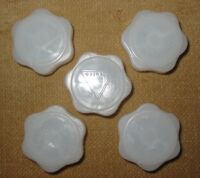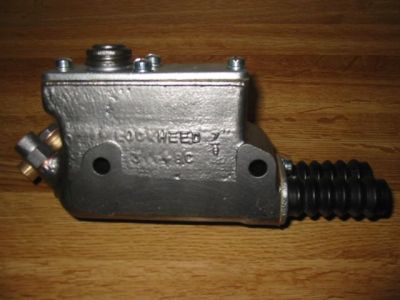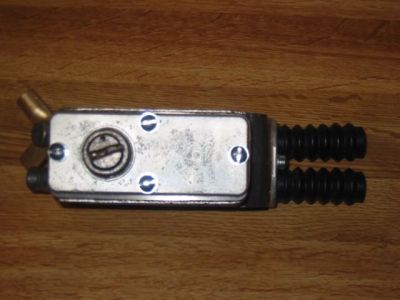|
We are pleased to offer our program
for custom
rebuilding of early Sprite and Midget
master cylinders
|
We have made every effort to insure that all the
information presented is accurate and reliable, but we are not Spridget experts and so there
will undoubtedly be inadvertent errors that will have to be corrected as they
are found. Since we are getting much help with this project from Gerard Chateauvieux of
Gerard's Garage and
Gallery, we hasten to add that any errors will be our fault and not his. |
POST-RETIREMENT UPDATE!!!
Gerard has advised us
that he is now able to offer this service--
Email Gerard
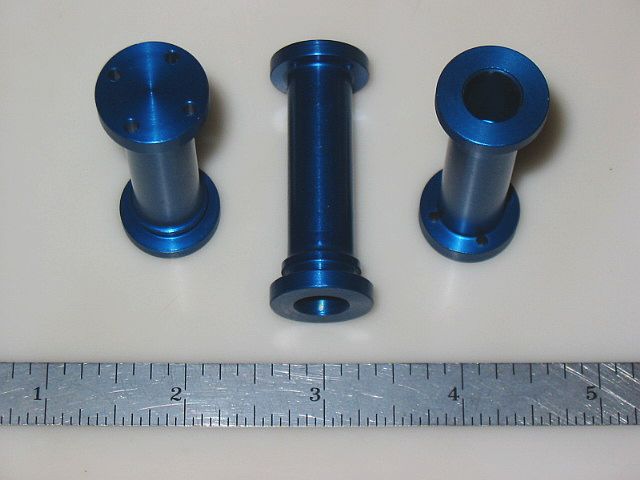
Master Cylinders for early MG Midgets and
Austin-Healey Sprites
| Many restorers, resto-modders and customizers have converted drum-brake
Spridgets to front disk brakes using spindles, hubs and brake parts from 1098cc
cars. Others have upgraded 948cc cars with a later engine
and transmission. A few have done both. In a high percentage of cases, problems
are encountered with the combination
clutch/brake master cylinder. The 948cc drum brake cars (HAN5/6 Sprites and GAN1 Midgets) used a master
cylinder with 7/8" bores in both sides. The wheel cylinders and clutch slave
cylinder were all sized to work properly with the fluid volume and pressure
supplied by the 7/8" bore. The 1098cc disk brake models (HAN7/8 and GAN2/3) used a master
cylinder with 3/4" bores in both sides, and the front calipers, rear wheel
cylinders, and clutch slave cylinder were all sized appropriately.
Nowadays, 3/4" master cylinders are very difficult to find, so most people
are forced to use the 7/8" master cylinder in their conversion. The area of the
7/8" piston is about 36% greater than the area of the 3/4" piston. This means
that the pedal effort required for clutch and brake operation is 36% higher with the larger
cylinder. It also means that clutch slave piston travel is 36% greater.
The increase in required pedal effort results in significant safety and
drivability issues, and the increased slave piston travel can cause mechanical problems with the
throwout linkage.
This is well illustrated in the photo below, sent to us by a customer with a 1275
engine and transmission. After installing a master cylinder with a 3/4" clutch
bore, this customer reported a great improvement in clutch pedal feel and
operation.
|
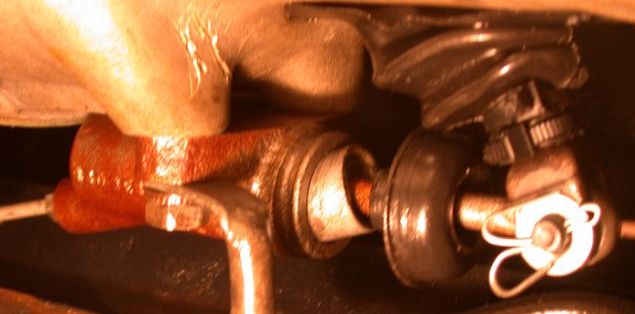
| Owners who have done both the brake and running gear conversions would be
well served by a stock 3/4" master cylinder, IF they could find one. But the
many owners who have done only one or the other require a cylinder with
different-sized bores, which has never been available--until now. We have developed a program to convert 7/8" master cylinders to 3/4" on
either the brake or clutch side, or both. These conversions are accomplished
using custom-manufactured 3/4" pistons and stock Spridget rebuild parts. They
are every bit as safe and reliable as the original cylinders, and are set up to
suit the exact needs of each customer. Since they use stock rubber parts, they
can easily be serviced in the future as needed. Shown below are the three
variations of this cylinder. The one on the left is sized for drum brakes and
1098 clutch, the one in the middle is for disk brakes and 1098 clutch,
and the one on the right is for disk brakes and 948 clutch.
|
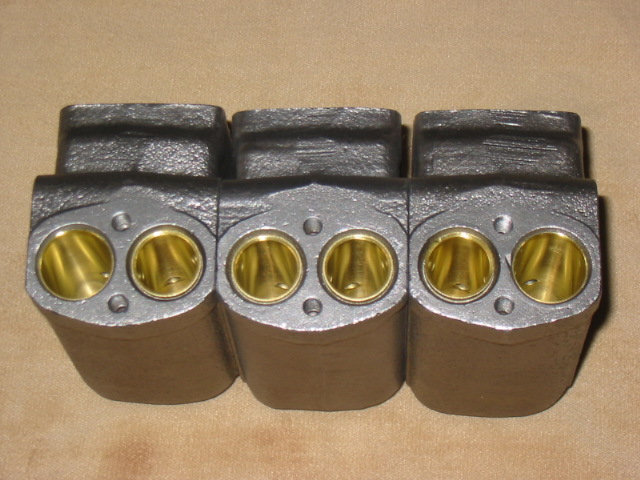
| Our friend and customer Gerard Chateauvieux provided the initial impetus for this
program, and has written his own
description of the project on his website. Gerard's site,
Gerard's Garage and Gallery, is an
excellent resource for owners of Little British Cars, especially the MG Midget
and Austin-Healey Sprite. |
"Roadstar" Cylinders
| There are a large number of cylinders of both sizes that were serviced by a
company in Sacramento CA called Roadstar. Their process involved boring the
castings larger by about 0.025" and fitting their own custom pistons and rubber
parts. Here at Sierra Specialty Automotive, we could easily sleeve these castings to
the Roadstar dimensions. Apple
Hydraulics in New York bought out Roadstar and stocks the oversized
rubber parts. If a "Roadstar" cylinder still has a clean bore with no
pits, one could get new rubber from Apple and do an acceptable rebuild.
However, we much prefer to sleeve cylinders
back to the original diameters and fit them with correct pistons that use stock
rubber parts. While it is certainly possible for us to sleeve a Roadstar
7/8" cylinder down to 3/4", it involves additional machining and significantly
more expensive tube stock so we prefer not to do so. We almost always have stock
cores that we can exchange at no charge in this situation. We then sleeve the
Roadstar cylinders to 7/8" for MGA and drum-brake Spridget customers. 3/4" Roadstar
cylinders can easily be restored to 3/4".
Shown below is a cylinder with the Roadstar tag. In many
cases the tags are missing. Most of them are also stamped with a number in
digits 1/4" tall on the side opposite the tag.
|
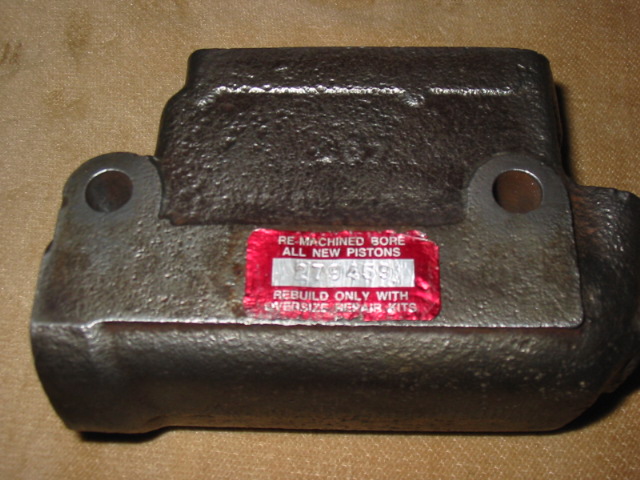
Original and Roadstar Piston Variations
| This photo shows the different pistons we have seen so far in
these cylinders. We believe the black coated pistons on the far left and far
right are from newer OEM replacement cylinders. The plain steel 7/8" piston
second from left is probably from an original cylinder. Not shown is a plain
steel version of the OEM 3/4" piston. Note that the original pistons of both
sizes have a seal locating rib under the head, which interlocks with a matching
groove in the original seals. The seals used on the Roadstar pistons had no such
groove and were held in place by the second rib, which is nearly full diameter. The
Roadstar pistons measure about 0.775" and 0.900" in diameter. |
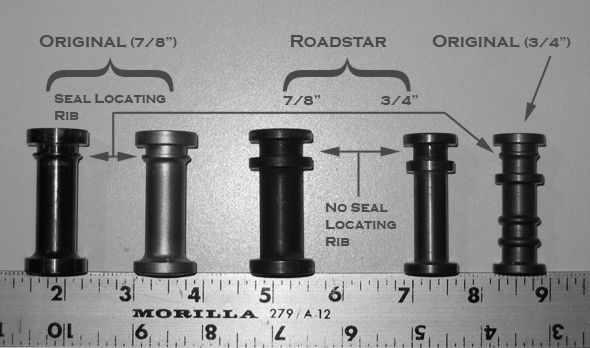
photo courtesy of
Gerard's Garage
Technical Issues
| At first glance, it might seem a simple thing
just to make 3/4" pistons, but the situation is a little more complicated. In
addition to the obvious difference in diameter, there are two other important
differences. The 3/4" pistons are about 0.050" shorter, and the pushrod socket
is about 1/2" shallower than the 7/8" pistons. The fluid ports in the bottom of
the reservoir of the 3/4" casting are drilled to match the shorter piston
length, and the pushrods used in the later cars are 1/2" shorter as well. Click
on a thumbnail image below for a larger view. The pushrod lengths are 3-11/16"
for the disk brake cars and 4-3/16" for the drum brake cars. Only the longer
pushrods are currently available from the usual vendors, but we have short
pushrods, pictured below at right, for sale to our sleeving and rebuilding customers. Note that
master cylinders salvaged from MGA cars may include MGA pushrods, which are
similar to Spridget pushrods except that they are 4-7/16" long and have a
1/2" hex instead of 3/8". |
|

port spacing varies to match piston length |
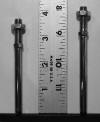
photo courtesy of
Gerard's
Garage |

our new short pushrods |
click on a thumbnail for a larger
view
| Some owners will have a 3/4" Roadstar casting and need pistons for
both sides, and some owners will have 7/8" castings and need pistons for one or
both sides. We can accommodate the different castings with our pistons by making
them in both lengths. The pushrod issue cannot be solved quite so simply. Since
the 3/4" piston is smaller in diameter, the pushrod socket is also smaller in
diameter, by about 1/16", and there is less room for the up-and-down
articulating motion of the pushrod as the pedal is depressed. If the socket were
drilled deeper to receive the longer pushrod, the pushrod would bear against the
bottom of the socket as the clutch pedal is depressed. Short pushrods are, therefore, required for proper
operation. You can shorten your drum brake or MGA pushrods by cutting them to the
3-11/16" length and grinding the round profile on the end. We will be happy to
shorten pushrods at no charge for our sleeving and rebuilding customers.
Send us your old, rusted cylinder and tell us what brakes
and running gear you have. We'll build it into a custom unit that will
operate your brakes and clutch with the same pedal feel and system performance
that was present in the original cars.
|
Springs
| There are also differences between the return springs in
the 948 and 1098 cylinders. The significant difference is in the diameter of the
end of the spring where it fits over the residual valve. The plastic valve used
in the later cars is larger than the stamped metal valve body used in the early
cylinders, so the later return springs are larger at one end rather than
tapering to smaller diameters at both ends. The double-tapered 948
spring will work perfectly in a 3/4" clutch-side bore, but will not work as is
in a 3/4" brake-side bore. The 948 spring can be replaced with a new 1098
spring, part number
181-710 at Moss
Motors, or it can be opened up at one end with pliers until the plastic valve
fits and is roughly square with the spring. Pictured at left is a new 948
spring with the metal stamping fitted, at middle is a new 1098 spring with
plastic valve, and at right a re-worked 948 spring. We install a new or a very
good used 1098 spring in the brake side of cylinders that we sleeve and rebuild,
and offer new 1098 springs to customers who take sleeving only for $6. |
| 2011. As of Mid-September, there is still no estimated
re-stocking date. We are currently having to modify 948 springs for the
brake side of our conversions. |
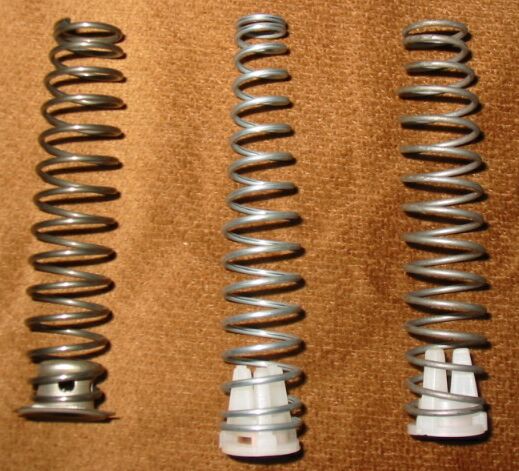
Cylinder Finishes
|
Many customers inquire about finishes
that are resistant to brake fluid. We have used
VHT Brake Caliper,
Drum, and Rotor paint with good results. Start with a clean casting,
mask plug ports and gasket surfaces, apply two thin coats, allow to dry
overnight, then cure in an oven at 300 degrees for an hour. There is minimal odor since most of the volatiles go away during the
air-dry, so you can do it in the kitchen without triggering a divorce. From our
experience, one can will do about four typical master cylinders. It makes a very
tough coating that is very resistant to brake fluid. We understand that original Spridget master cylinders were
bare metal, or "rust" as one source put it, so the Cast Aluminum paint would probably be most "correct"
although it is much brighter than cast iron. Our
personal preference is the Satin Black color. We try to keep in stock Gloss Black, Satin Black,
Bright Blue, Real Orange, Bright Yellow, Cast Aluminum, and Real Red, and we will paint
and bake your cylinder for $25 if you prefer not to do it yourself. Painting
should be done after sleeving. Plating or powder-coating should be done before
sleeving. See our
Brake FAQ entry for more information about painting.
Click on the thumbnails below to see cylinders with
bare castings rebuilt and
ready to install, and a casting
finished in Satin Black.
|
We Include with Your Cylinder...
|
...new gaskets for the lid and the piston
retaining cover. We also include new fillister-head machine screws and
internal-tooth lockwashers as used originally. Current price from the usual
vendors for the gaskets and screws is over $12.00. Our price? Zero...zip...nada.
We also include a new Lockheed filler cap
with each complete rebuild job, or sell them with sleeving for $7. This offer is
subject to availability of new caps.
|
Rear Brakes
| Owners who convert to the disk front brakes should also convert
the rear drum brakes to match. Gerard has written up a
great discussion of this on his website, and we strongly encourage you to read and
heed. |
On the Origin of Species
|
The first master cylinder of this style was
used in the MG Magnette ZA and ZB, and TR2-early TR3. The most obvious
difference is that the Spridget/MGA cylinder lid is retained with 5 capscrews,
while the Magnette/TR lid has 4 screws. The Spridget/MGA casting number is
38183, and the Magnette/TR casting number is 31448. Other differences are that
the Magnette bore is about 5/16" deeper and the outlet ports are threaded
3/8"-20 (Whitworth) rather than 3/8"-24 (Imperial). The Magnette cylinder is
assembled with the residual valve for the brakes on the right side looking into
the bores, while the Spridget cylinder is assembled with the valve on the left.
The Magnette uses the bellows boots shown rather than the flat boots used on the
Spridget cylinders.
All internal parts and the front piston retaining plate are the
same between the two cylinders, as is the mount bolt spacing.
If a Magnette or TR is re-fitted with brakes or clutch that
originally used a 3/4" master cylinder, our conversion would be applicable to
this cylinder.
|
Pricing
| The vast majority of these old cylinders are rusted and pitted, and require
sleeving to restore them to reliable, safe operating condition. Accordingly, we
start with the assumption that the cylinders we convert will be sleeved. Our
standard sleeving price of $145 for double-bore cylinders applies regardless of
original or finished size. We also offer complete rebuilding, which includes all
rubber parts and assembly in addition to sleeving, for $205. Again, this price
applies regardless of original or finished size. Add to these prices $40 per
piston for one or two as needed. Note that for California customers, we must
charge tax on rebuilding as well as the cost of pistons. We are not required to
charge tax on sleeving only, or on sales outside California. All sleeved cylinders are supplied with new
gaskets, fillister head machine screws, and internal tooth lockwashers. Rebuilt
cylinders are also supplied with a new Lockheed filler cap (when available). Pushrod shortening
service is included at no charge with sleeving or rebuilding. New correct-length
pushrods with jam nuts are $12 each. Sleeving customers can buy new filler caps for
$7. The best new cylinder currently available from the usual US vendors is a Lucas
replacement for the 7/8" master cylinder, priced typically at about $300. While
it is perfectly suited to drum-brake Spridgets with original running gear, it is
not at all suited to 1098 Spridgets nor to an upgraded older car. (There is also
a 7/8" off-shore repop available for about $210, but we have heard of quality
issues with these.) Your cylinder
sleeved and rebuilt by Sierra Specialty Automotive will cost $245 if fitted with
one new piston, and $285 if fitted with two--That's still less than the
good replacement which does not meet your needs. If you wish to buy a complete
cylinder outright, add our core charge of $75.
We ask that you send your cylinder complete, but drained of fluid, and
double-wrapped in plastic bags to prevent fluid leakage from the package.
|
|













